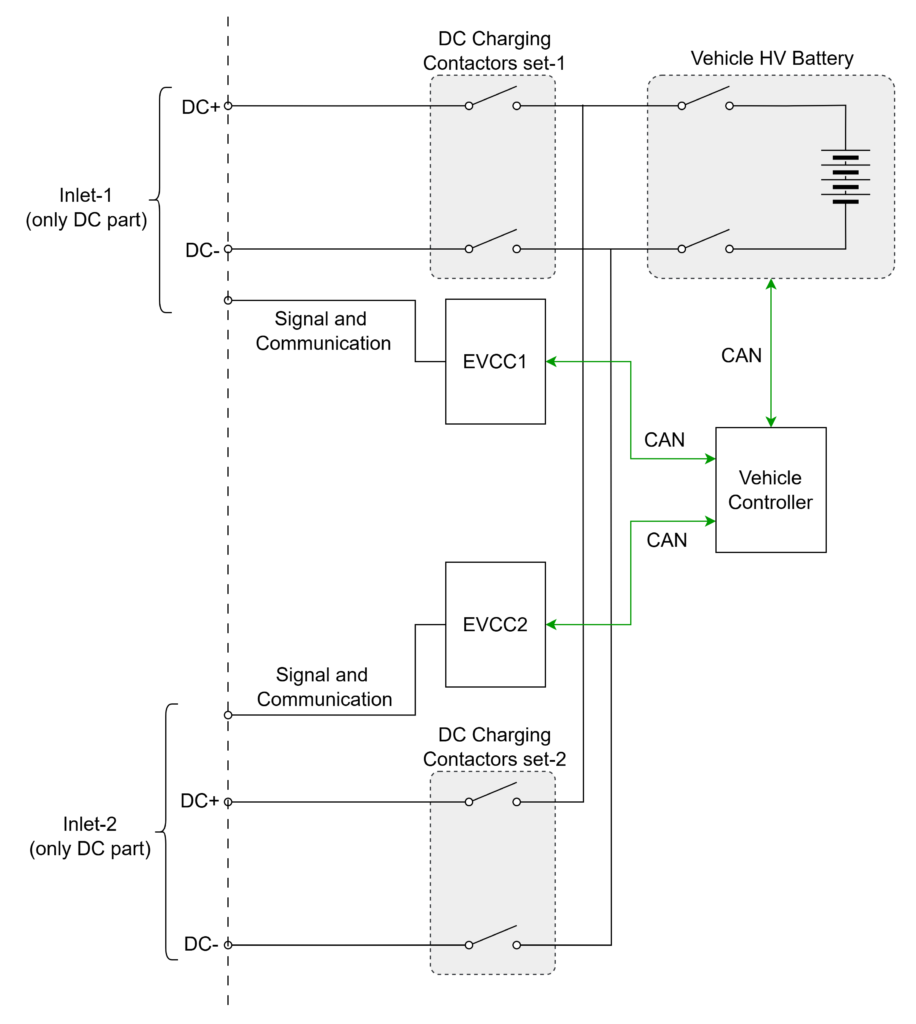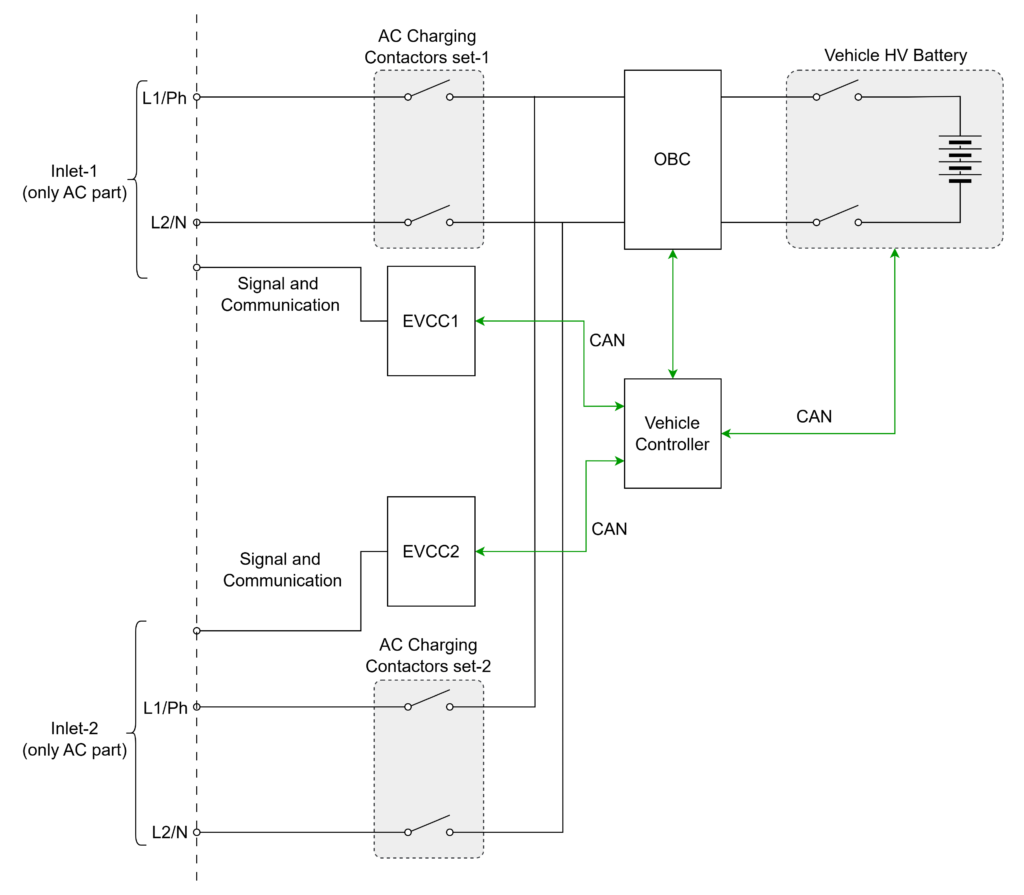Dual Charging Inlets in Bigger EVs – And Why Only One is Used at a Time?
To gain a clearer understanding of this article, please begin by reading below articles:
Current Control in DC Charging for EVs
Current Control in AC Charging for EVs
As electric vehicles (EVs) become more mainstream, their presence is no longer limited to small cars or small vehicles running in city streets. Today, larger EVs like electric buses, trucks, and commercial vans are becoming increasingly common. With these larger vehicles come new engineering challenges—particularly when it comes to charging convenience and safety.
One feature you’ll often notice in bigger EVs is the presence of two charging inlets, typically located on opposite sides of the vehicle. At first glance, this might seem excessive or redundant. So, why do large EVs need two charging ports, and more importantly, can they be used simultaneously?
Let’s explore the logic, safety considerations, and technical workings behind this dual-inlet setup.
Why Two Charging Inlets?
For buses and other large electric vehicles, manoeuvrability at charging stations can be a real challenge. These vehicles are significantly longer and wider than standard cars, making it harder to align precisely with a fixed charging spot. And since not all charging stations are uniformly designed, the charger might be on the left or right side, depending on the location.
To solve this, manufacturers often equip these vehicles with two charging inlets—one on each side. This gives drivers flexibility and convenience. Whether the station is on the left or right, the vehicle can be charged without requiring complex parking manoeuvres or reversing.
The Technical Design: How Does Dual Inlet Charging Work?
Let’s break down the core architecture behind this setup. The following outlines the setups for both DC and AC charging. For clarity, AC and DC are presented separately; however, they may originate from the same inlet in the case of CCS, while they are distinct in GBT and CHAdeMO systems.


Each charging inlet is monitored by its own Electric Vehicle Communication Controller (EVCC)—EVCC1 and EVCC2.
The Charging Process:
- Both EVCCs continuously monitor whether a charging cable is connected.
- Whichever inlet is connected first becomes the active charging inlet.
- For example, if a cable is connected to Inlet-1 first:
- EVCC1 detects the connection and communicates with the Vehicle Controller.
- The Vehicle Controller activates Charging Contactor Set-1, enabling power flow from Inlet-1.
- Simultaneously, Contactor Set-2 remains open, ensuring Inlet-2 is inactive.
- EVCC1 detects the connection and communicates with the Vehicle Controller.
- This is crucial because if Inlet-2’s contactors are accidentally closed while power is active on Inlet-1, it could expose high voltage at Inlet-2, posing a serious safety risk to anyone near the port.
This logic applies in reverse too. If Inlet-2 is connected first, then charging occurs from that side, while Inlet-1 remains inactive.
But Can Both Inlets Be Used at the Same Time?
It’s a common question: If a vehicle has two charging inlets, why not use both simultaneously to either charge faster or provide load balancing? While it may sound like a clever idea, charging from both inlets at the same time is not allowed—and for very good reasons.
1. Safety Hazards in DC Charging
Allowing simultaneous charging from two inlets, especially DC fast charging, could create dangerous conditions:
- Different Charging Station Behavior: Each station may operate slightly differently and respond to EV requests in unique ways. This can lead to voltage mismatches.
- Risk of Power Flow Between Chargers: If both contactor sets (Set-1 and Set-2) are closed while cables are connected to both inlets, power could flow between the two chargers through the vehicle. This not only risks damaging the vehicle’s internal systems but could also lead to unpredictable and hazardous results.
2. Risks in AC Charging: Phase Mismatch
Even with AC charging, trying to utilize both inlets simultaneously introduces serious complications. Consider this:
- If Inlet-1 is connected to Phase 1 of the grid, and Inlet-2 is connected to Phase 2—either intentionally by AC charging stations for load balancing or unintentionally—this could cause a phase mismatch.
- The result? A short circuit between the phases and severe system damage.
This kind of phase conflict would pose a significant fire and equipment hazard, making it strictly unacceptable from a safety and regulatory perspective.
3. User Behavior Management
The system is also designed to intentionally discourage connecting both inlets, even accidentally:
- When the first charging cable is connected, the respective EVCC detects the connection and informs the Vehicle Controller, which then begins the charging process from that inlet.
- If a second charging cable is connected later, the other EVCC will report it—but the Vehicle Controller will ignore the second connection and continue charging only from the first inlet.
- In some cases, the system may even terminate the entire charging session to signal to the user that connecting both inlets simultaneously is not acceptable.
This mechanism not only ensures system safety but also educates users on correct charging practices, helping prevent dangerous habits from forming.
Hence, to mitigate risks and protect the vehicle, charging is allowed from only one inlet at a time—whichever is connected first.
Designed with Safety in Mind
While the idea of dual inlets might seem like a way to double up on power, in reality, it’s a smart and safe design choice made to accommodate the challenges faced by larger EVs. The dual-inlet system provides maximum convenience without compromising on user safety or electrical integrity.
This article focuses on the standard use case. While it is technically possible to modify the components and architecture to enable simultaneous charging from both inlets, such a setup is not commonly used at present.
EV Charging Explained – Everything you need to know about Electric Vehicle Charging